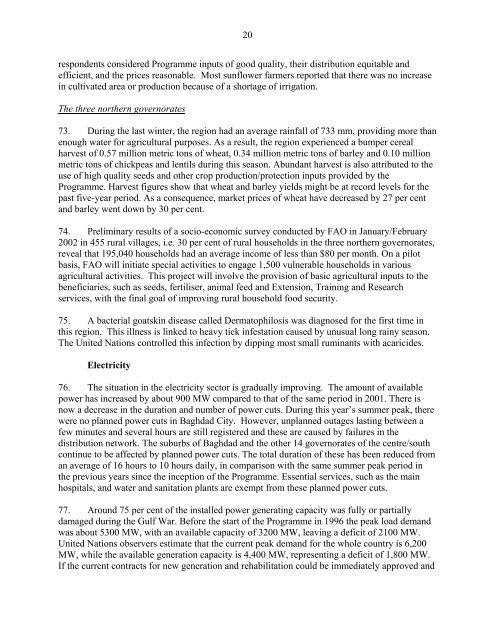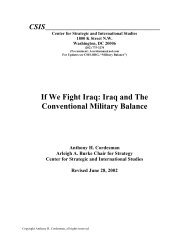I. Introduction II. Revenue generation
I. Introduction II. Revenue generation
I. Introduction II. Revenue generation
Create successful ePaper yourself
Turn your PDF publications into a flip-book with our unique Google optimized e-Paper software.
20respondents considered Programme inputs of good quality, their distribution equitable andefficient, and the prices reasonable. Most sunflower farmers reported that there was no increasein cultivated area or production because of a shortage of irrigation.The three northern governorates73. During the last winter, the region had an average rainfall of 733 mm, providing more thanenough water for agricultural purposes. As a result, the region experienced a bumper cerealharvest of 0.57 million metric tons of wheat, 0.34 million metric tons of barley and 0.10 millionmetric tons of chickpeas and lentils during this season. Abundant harvest is also attributed to theuse of high quality seeds and other crop production/protection inputs provided by theProgramme. Harvest figures show that wheat and barley yields might be at record levels for thepast five-year period. As a consequence, market prices of wheat have decreased by 27 per centand barley went down by 30 per cent.74. Preliminary results of a socio-economic survey conducted by FAO in January/February2002 in 455 rural villages, i.e. 30 per cent of rural households in the three northern governorates,reveal that 195,040 households had an average income of less than $80 per month. On a pilotbasis, FAO will initiate special activities to engage 1,500 vulnerable households in variousagricultural activities. This project will involve the provision of basic agricultural inputs to thebeneficiaries, such as seeds, fertiliser, animal feed and Extension, Training and Researchservices, with the final goal of improving rural household food security.75. A bacterial goatskin disease called Dermatophilosis was diagnosed for the first time inthis region. This illness is linked to heavy tick infestation caused by unusual long rainy season.The United Nations controlled this infection by dipping most small ruminants with acaricides.Electricity76. The situation in the electricity sector is gradually improving. The amount of availablepower has increased by about 900 MW compared to that of the same period in 2001. There isnow a decrease in the duration and number of power cuts. During this year’s summer peak, therewere no planned power cuts in Baghdad City. However, unplanned outages lasting between afew minutes and several hours are still registered and these are caused by failures in thedistribution network. The suburbs of Baghdad and the other 14 governorates of the centre/southcontinue to be affected by planned power cuts. The total duration of these has been reduced froman average of 16 hours to 10 hours daily, in comparison with the same summer peak period inthe previous years since the inception of the Programme. Essential services, such as the mainhospitals, and water and sanitation plants are exempt from these planned power cuts.77. Around 75 per cent of the installed power generating capacity was fully or partiallydamaged during the Gulf War. Before the start of the Programme in 1996 the peak load demandwas about 5300 MW, with an available capacity of 3200 MW, leaving a deficit of 2100 MW.United Nations observers estimate that the current peak demand for the whole country is 6,200MW, while the available <strong>generation</strong> capacity is 4,400 MW, representing a deficit of 1,800 MW.If the current contracts for new <strong>generation</strong> and rehabilitation could be immediately approved and
















